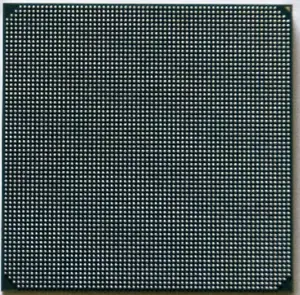| Line 15: | Line 15: | ||
|package module 1={{packages/nudt/fclga-4201}} | |package module 1={{packages/nudt/fclga-4201}} | ||
}} | }} | ||
| + | [[File:matrix-2000 (back).png|300px|thumb|right|Matrix-2000 Ceramic LGA package back side.]] | ||
'''Matrix-2000''' is a [[128-core]] [[many-core processor]] designed by [[NUDT]] and introduced in [[2017]]. This chip was designed exclusively as an accelerator for [[China]]'s [[Tianhe-2]] supercomputer in order to upgrade and replace the aging [[Intel]]'s {{intel|Xeon Phi|Knights Corner}} accelerators after the Obama administration banned the sale of high-performance accelerators to China. The Matrix-2000 features 128 [[RISC]] cores operating at 1.2 GHz achieving 2.46 [[TFLOPS]] with a peak power dissipation of 240 W. | '''Matrix-2000''' is a [[128-core]] [[many-core processor]] designed by [[NUDT]] and introduced in [[2017]]. This chip was designed exclusively as an accelerator for [[China]]'s [[Tianhe-2]] supercomputer in order to upgrade and replace the aging [[Intel]]'s {{intel|Xeon Phi|Knights Corner}} accelerators after the Obama administration banned the sale of high-performance accelerators to China. The Matrix-2000 features 128 [[RISC]] cores operating at 1.2 GHz achieving 2.46 [[TFLOPS]] with a peak power dissipation of 240 W. | ||
Revision as of 22:17, 20 October 2017
Matrix-2000 is a 128-core many-core processor designed by NUDT and introduced in 2017. This chip was designed exclusively as an accelerator for China's Tianhe-2 supercomputer in order to upgrade and replace the aging Intel's Knights Corner accelerators after the Obama administration banned the sale of high-performance accelerators to China. The Matrix-2000 features 128 RISC cores operating at 1.2 GHz achieving 2.46 TFLOPS with a peak power dissipation of 240 W.
Overview
The original TianHe-2 (Milkyway-2) was powered by 16,000 servers consisting of Intel's Xeon and Xeon Phi accelerators. Those accelerators were based on Knights Corner. Originally, NUDT announced they would be upgrading the supercomputer to Intel's then-latest Phi Knights Landing accelerators. The new supercomputer was renamed 'TianHe-2A'. In February 2015, under the Obama administration, the Department of Commerce blacklisted NSCC-G (the site of the TianHe-2A) and NUDT as well as the previous supercomputer center. The DoC cited concerns regarding nuclear explosive devices and other related computer research and simulations.
Chuck Mulloy, an Intel spokesperson later gave the following statement:
Intel was informed in August by the U.S Department of Commerce that an export license was required for the shipment of Xeon and Xeon Phi parts for use in specific previously disclosed supercomputer projects with Chinese customer INSPUR. Intel complied with the notification and applied for the license which was denied. We are in compliance with the U.S. law.
Due to the ban NUDT was unable to obtain the Xeon Phis they've hoped for in order to upgrade the system. To achieve the desired upgrades without the embargoed parts, NUDT developed the Matrix-2000 accelerators. While not nearly as powerful as Knights Landing, the chips were more powerful than the first-generate Knights Corner parts they have replaced. While original (KL) system was planned to exceed 110 PFLOPS using the Intel parts, the Matrix-2000 managed to achieve 94.97 PFLOPS.
Architecture
The Matrix-2000 consists 128 cores, eight DDR4 memory channels, and x16 PCIe lanes. The chip consists of four supernodes (SN) consisting of 32 cores each operating at 1.2 GHz with a peak power dissipation of 240 Watts.
SuperNode (SN)
Four SuperNodes make up the chip. Each SuperNode network on a chip (NoC) is implemented as a 4 by 2 mesh topology for a total of 8 CPU Clusters. Each cluster consist of a router, a directory control unit (DCU), 4 CPU cores and a shared cache. Attached to each SuperNode are two DDR4 memory controllers at opposite ends. With 4 cores per node and 8 nodes per SuperNode, there are a total of 32 cores per SN. Compliance to cache coherence is done by the core.
Routing is done via the router at every one of the clusters. The router has four communication channels: Response, Request, Snoop, and Acknowledgement. Each channel is 128-bit wide.
Core
Each core is a reduced instruction set computer (RISC) featuring an in-order pipeline with 8 to 12 stages. The core incorporates an extended 256-bit vector instruction set architecture along with two 256-bit vector processing units (VPU). Each core is capable of performing 16 double-precision floating point operations each cycle.
Operating at 1.2 GHz, each core has a peak performance of 19.2 GFLOPs (1.2 GHz * 16 FLOP/cycle). With 32 such cores in each SuperNode, the peak performance of each SN is 614.4 GFLOPS. Likewise, with four SN per chip, the peak chip performance is 2.458 TFLOPS.
Memory controller
|
Integrated Memory Controller
|
||||||||||||||
|
||||||||||||||
| has ecc memory support | true + |
| max memory bandwidth | 143.1 GiB/s (146,534.4 MiB/s, 153.652 GB/s, 153,652.455 MB/s, 0.14 TiB/s, 0.154 TB/s) + |
| max memory channels | 8 + |
| supported memory type | DDR4-2400 + |
